The world's most eye-catching spectacles in stunning photos
Our planet's most astonishing displays
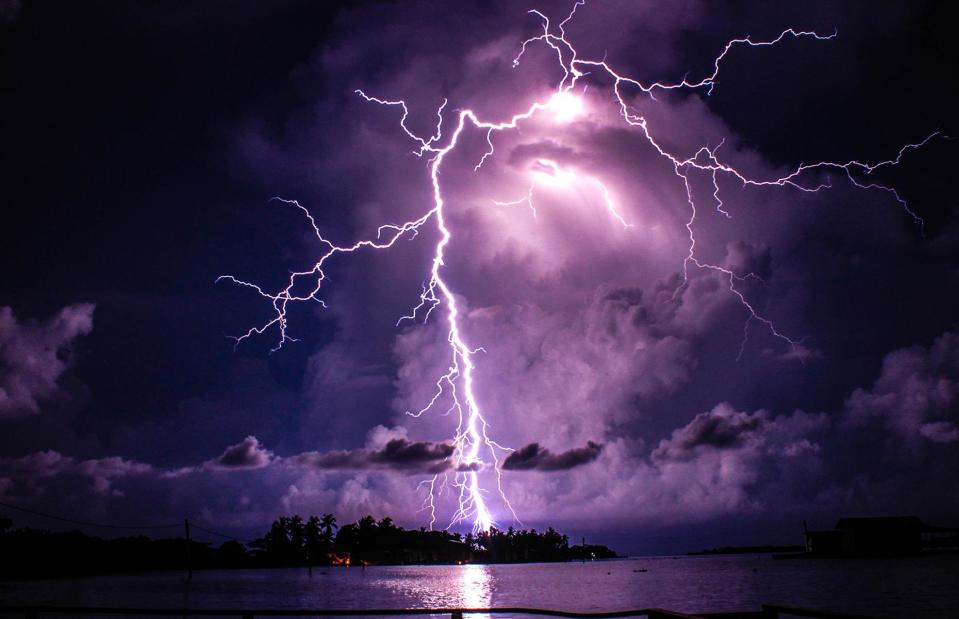
christianpinillo/Shutterstock
The natural world is full of surprises and there's a heap of stunning spectacles occurring all around the world every year.
From mesmerising light displays in the sky and water to jaw-dropping animal migrations and more, we bring you some of nature's most magnificent shows.
Elephant gathering in Minneriya National Park, Sri Lanka
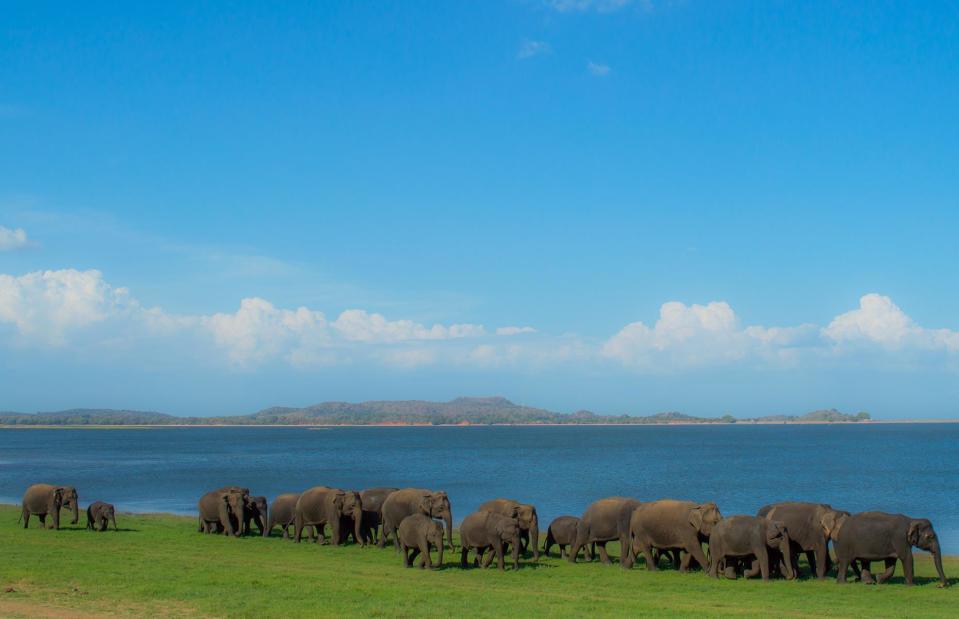
Miles Astray/Shutterstock
The biggest gathering of Asian elephants anywhere in the world, several hundred animals congregate at a watering hole in Minneriya National Park during the dry season, from July to early November, before moving to Kaudulla National Park. An incredible sight to see, especially as there are so many babies around this time of year, the large animals graze, drink, bathe and socialise here.
Migration of the monarch butterflies, Mexico
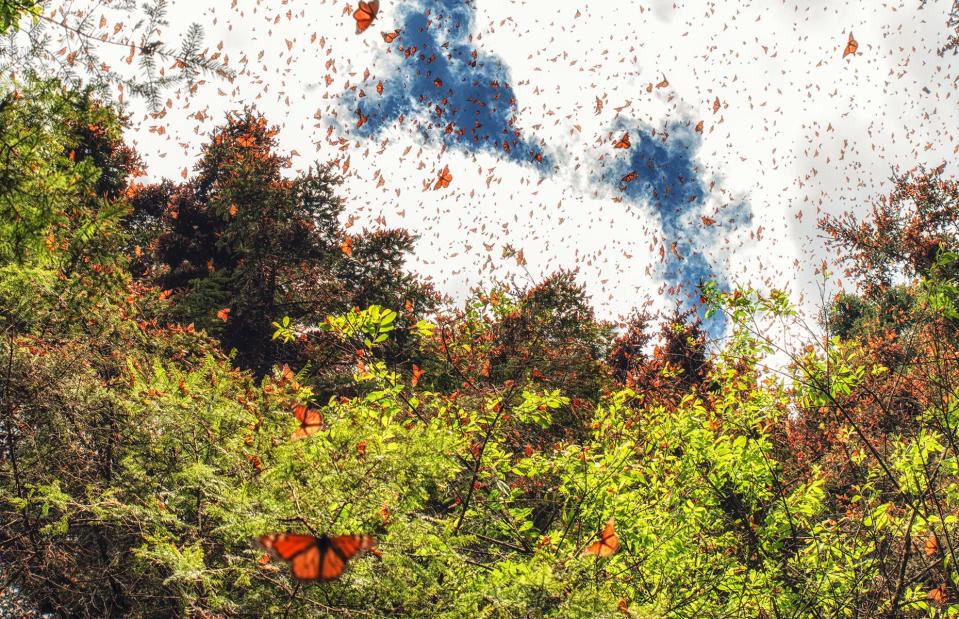
Atosan/Shutterstock
Each year, millions of butterflies descend on the butterfly reserves of Mexico State and Michoacán. Because the average monarch butterfly has a lifespan of just two to six weeks, the 2,485-mile (4,000km) migration path from Canada and the northeastern United States is undertaken by successive generations.
The butterfly population at the reserves hits its peak in January and February and it might take as many as four or five generations to complete the journey back up to Canada.
Wildebeest migration, Tanzania and Kenya
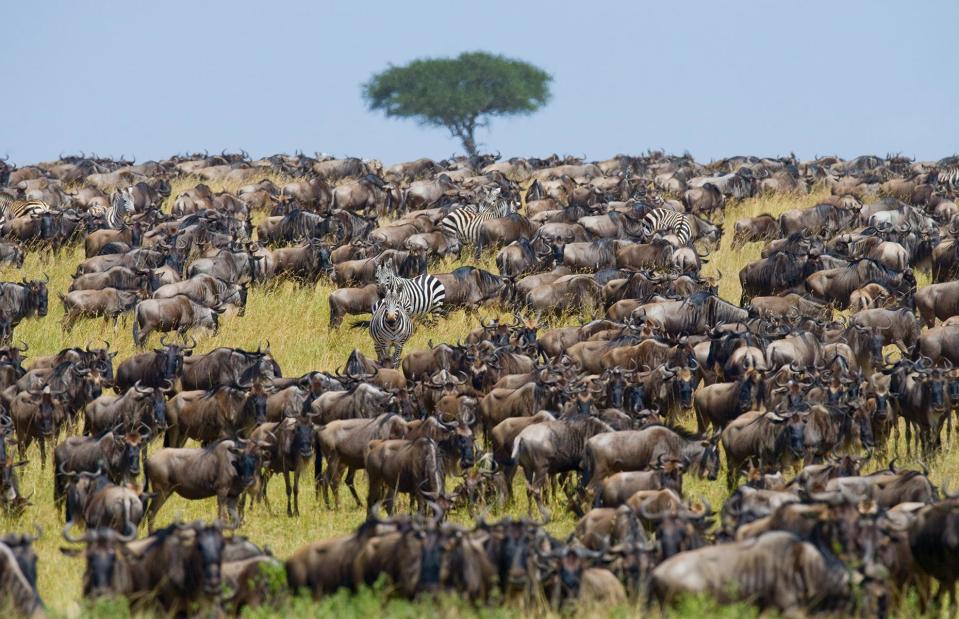
GUDKOV ANDREY/Shutterstock
Following the rainy season, the largest mammal migration on Earth sees 1.5 million wildebeest and zebra make an epic journey over a 11,583 square-mile (30,000sq km) area, travelling northwest from the plains of the Serengeti in search of greener pastures every year. This amazing sight can be seen at its best in May or June in either Tanzania’s Serengeti National Park or Kenya’s Maasai Mara National Reserve.
Sakura season, Japan
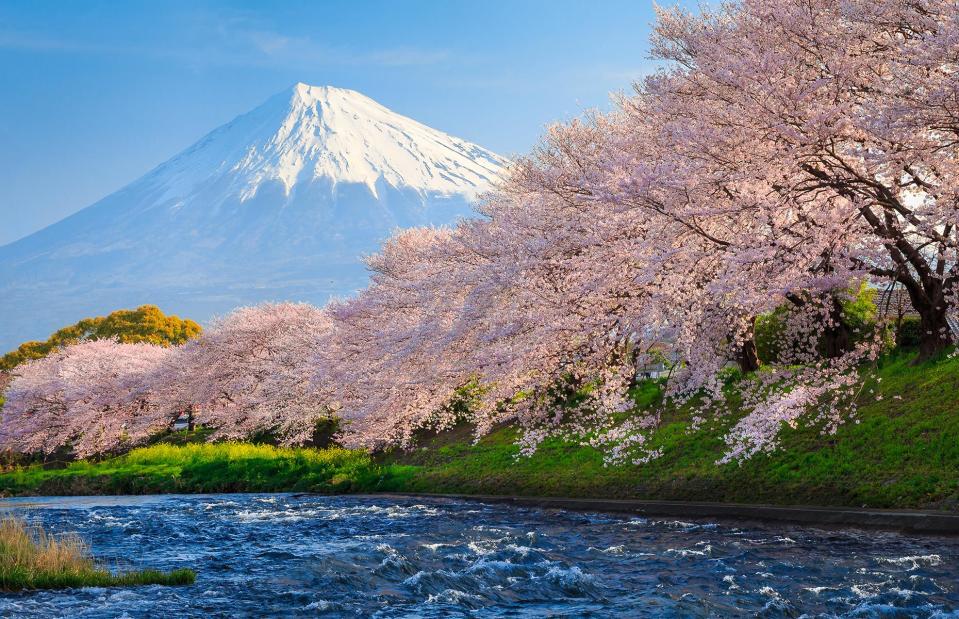
jiratto/Shutterstock
Each year the arrival of spring means Japan’s wealth of cherry-blossom trees reveal their blooms to the world and the age-old tradition of hanami (cherry-blossom viewing) can commence. On Japan's subtropical island of Okinawa the sakura can bloom as early as January, while the northernmost island Hokkaido can see its blooming as late as May. In central cities, such as Tokyo, Kyoto and Osaka, the season typically takes place in April.
Cherry blossoms in Washington DC, USA
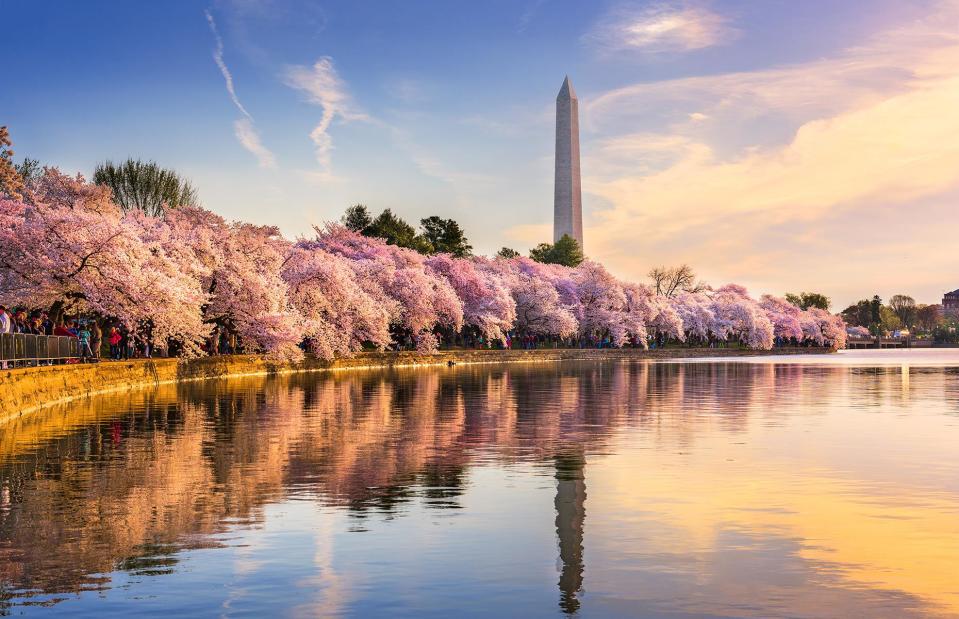
Sean Pavone/Shutterstock
Another place famous for its cherry blossom season is Washington DC. The arrival of the Yoshino cherry tree blossoms around the Potomac Tidal Basin and East Potomac Park is celebrated every year from late March to mid-April. The season is usually marked by the National Cherry Blossom Festival, which includes parades and family events.
Midnight sun, Svalbard, Norway
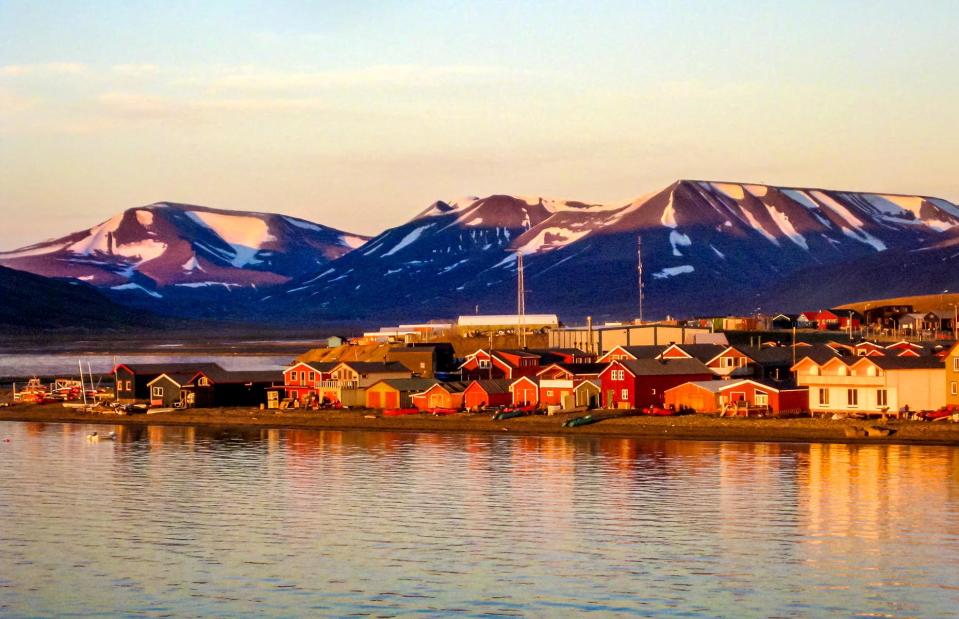
Kylie Nicholson/Shutterstock
A place where the sun never sets sounds like something out of a fairy tale, but this is exactly what happens each year in some locations north of the Arctic Circle and south of the Antarctic Circle. In the Norwegian archipelago of Svalbard the sun can remain high in the sky for up to 16 weeks, with evenings denoted by a crimson midnight sun.
Approximate dates for this period in Svalbard are from 20 April to 22 August.
Manhattanhenge, New York City, USA
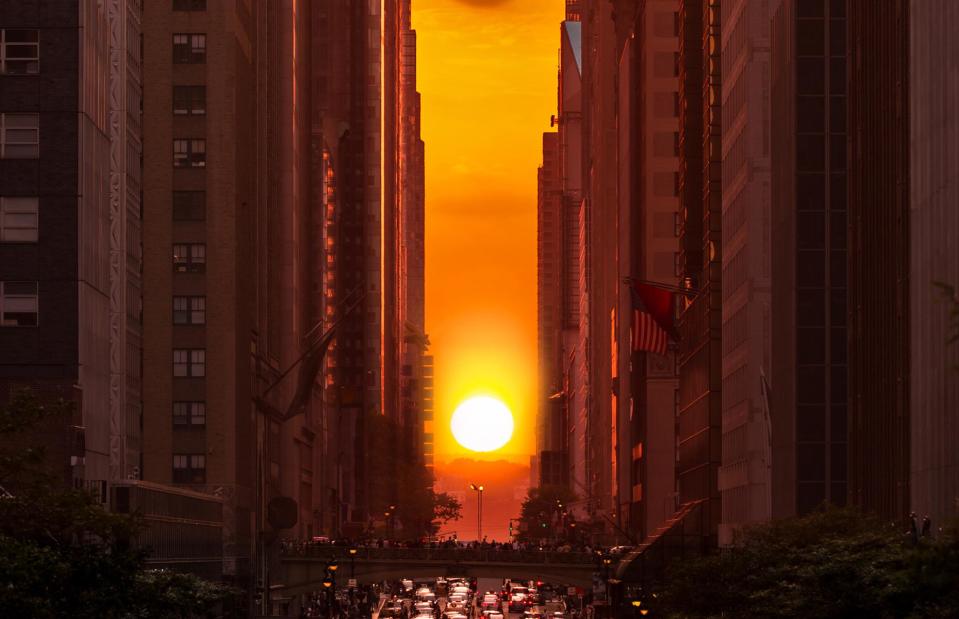
Mihai_Andritoiu/Shutterstock
The beating heart of New York City is the last place you'd expect to see Mother Nature at work. But for two evenings in May and July, the sun sets straight between the city’s skyscraper canyons, bringing the natural and man-made worlds together for a truly awe-inspiring moment.
Bluebell blooms in the UK
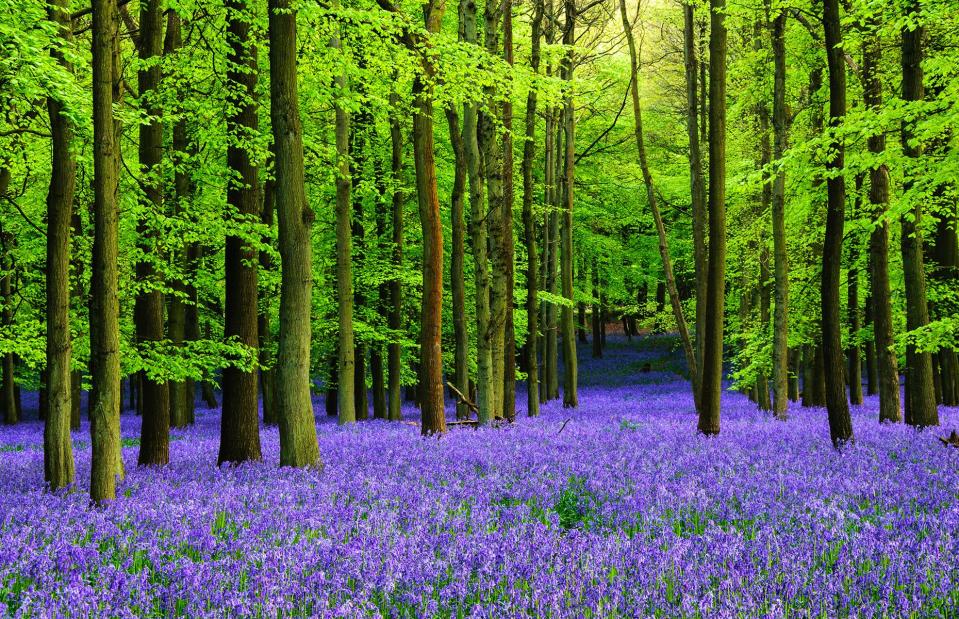
Tomas Burian74/Shutterstock
Covering ancient woodlands in a carpet of purple in April and May, bluebell flowering in the UK is an enchanting sight. Although bluebells grow across many parts of the country, some of the most beautiful places include Blickling Estate in Norfolk, Lake District National Park, Wepham Wood and Ashridge Estate in Hertfordshire.
Maple trees in fall, Québec, Canada
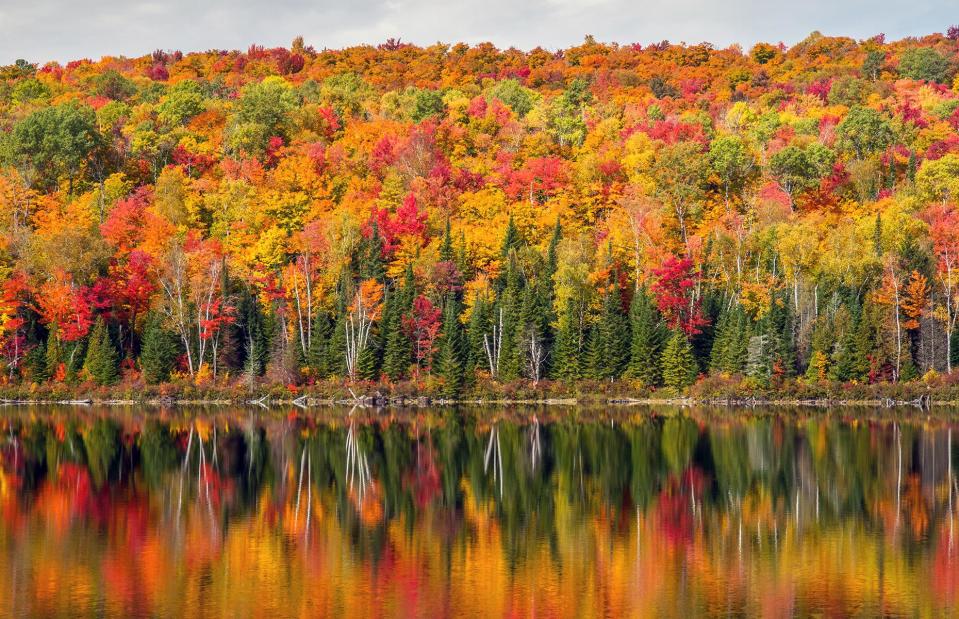
Pierre Leclerc/Shutterstock
Autumn is a colourful season everywhere in Canada, but no more so than in the province of Québec, which is rife with maple trees. The leaves turn bright orange or brilliant red in fall, covering the rolling hills of rural Québec in a blanket of colour for several weeks in October.
The trees also have a sweet season in the early spring, when their sap is tapped and turned into delicious maple syrup.
Northern Lights
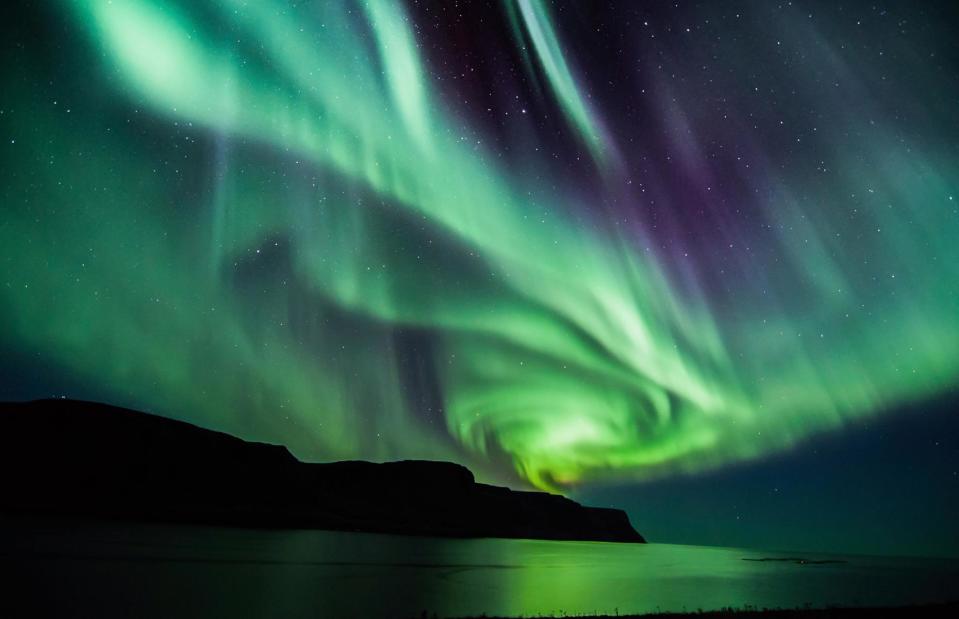
MikeDrago.cz/Shutterstock
The Northern Lights, or aurora borealis, is a natural light display occurring between late September and late March. Renowned for their magical appearance, these majestic purple and green bands of light cover a wide geographical area, however, some of the most spectacular shows happen above Iceland, as seen in this image.
Southern Lights
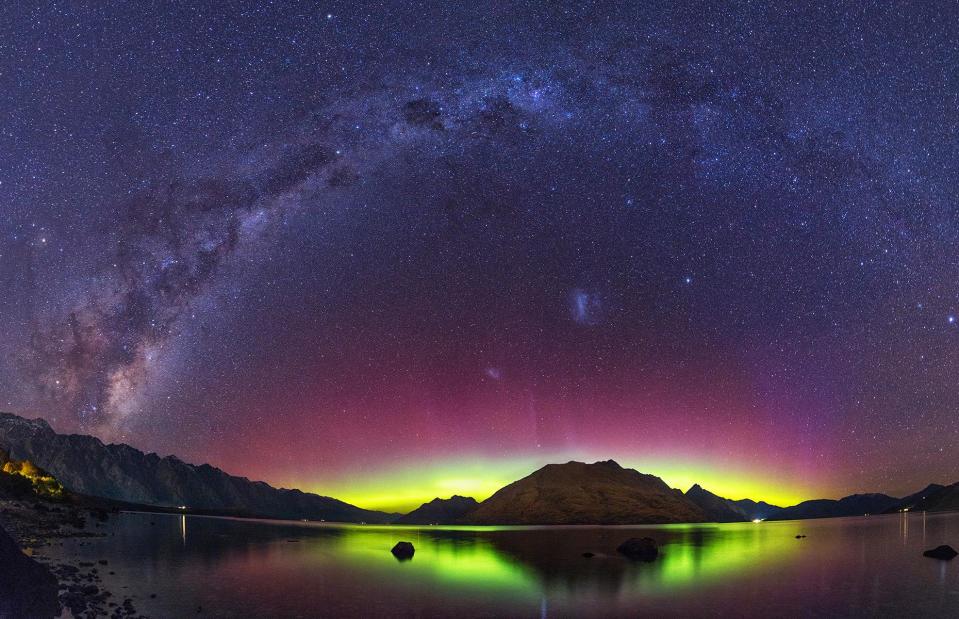
Mo_Chen/Shutterstock
Most people have heard of the Northern Lights, but the dazzling show offered in the Southern Hemisphere is equally as captivating. The aurora australis, or the Southern Lights, is a dancing curtain of light that glows in every shade from pink to green.
The result of energetic electrons colliding with atoms and molecules, this otherworldly multicoloured show can be seen in Antarctica, New Zealand, southern Australia, Chile and South Africa.
Hydrangeas in the Azores, Portugal
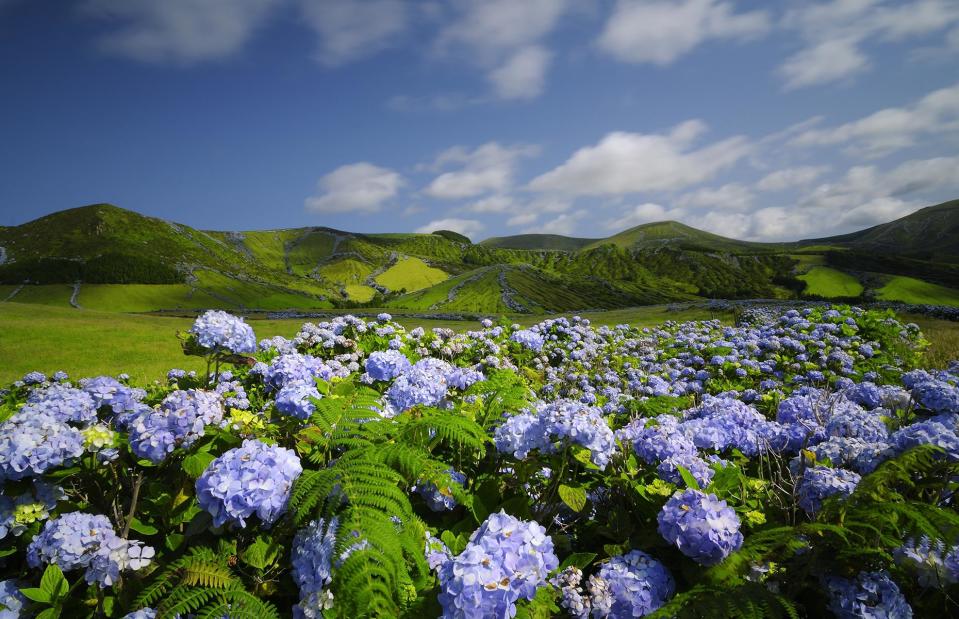
shine73/Shutterstock
While hydrangeas are not native to the Azores, they still put on an unbelievable show from late April up until early September. Thought to have been brought to the islands centuries ago by Portuguese missionaries and explorers, the island of Faial is the most famous for its abundance of hydrangeas.
Blanketed in a sea of purple, blue and sometimes pink, the hydrangea shrubs can grow as tall as six feet (1.8m) here.
Sardine run, east coast of South Africa
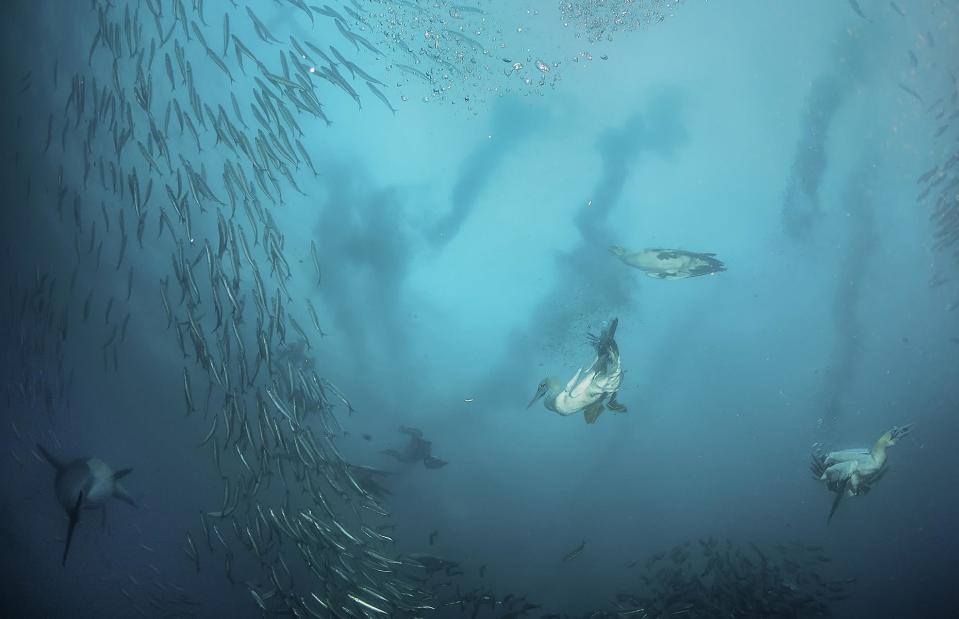
wildestanimal/Shutterstock
You might think that fish gathering in water isn't anything to get too excited about, however, it's different when it comes to the sardine run near the east coast of South Africa between May and July. As millions and millions of sardines bunch up around the Eastern Cape and the KwaZulu-Natal coast, thousands of seals, sharks and dolphins arrive too for the impeding feast.
And if an attack under water wasn't enough to deal with for the sardines, huge colonies of gannets arrive too, diving in the water like bullets to catch the fish.
Night-blooming cactus, Arizona, USA
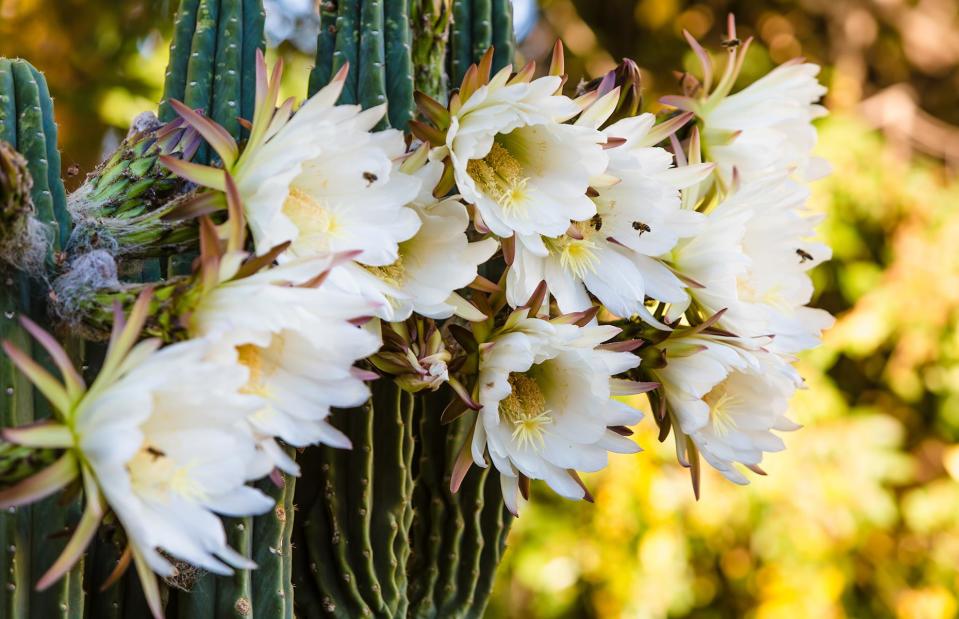
CREATISTA/Shutterstock
For just one night each year cereus, the collective name for a group of flower-producing cacti, open up to reveal their pretty white blossoms. Usually taking place in either May or June, this fleeting spectacle is most prominent in Arizona’s botanical garden of Tohono Chul.
Here more than 300 of these night-blooming plants are monitored around the clock in the hope that this phenomenon is captured as it unfolds. In the wild, cereus can be found in Sonoran and Chihuahuan deserts.
Noctilucent clouds, Finland
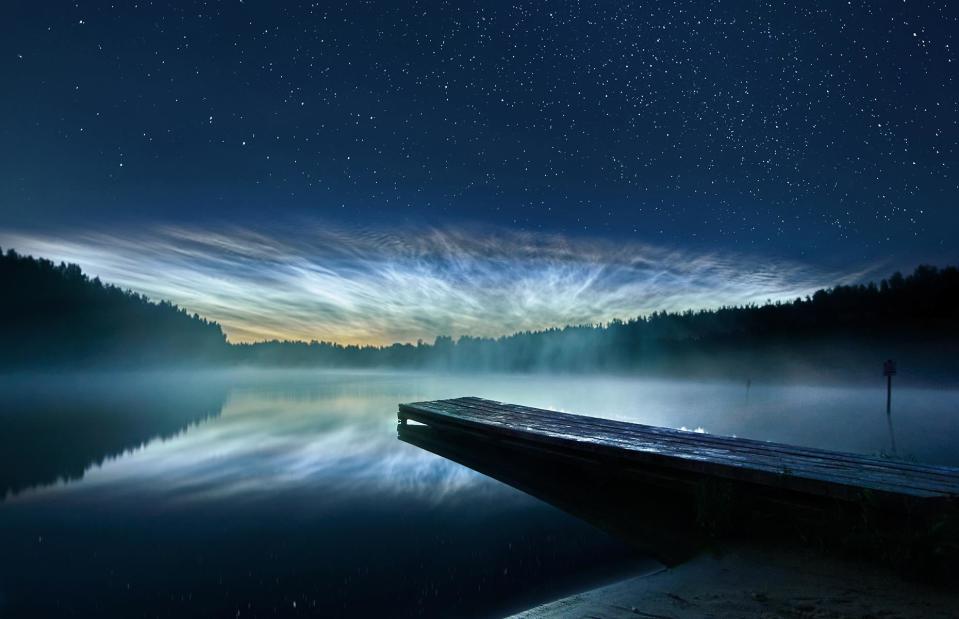
Anna Anikina/Shutterstock
Squeezed between Earth and space about 37 miles (60km) above ground, these electric-blue clouds are a result of ice crystals reflecting sunlight after sunset. Noctilucent clouds – sometimes called night shining clouds – only appear at latitudes between 45° and 80° north and south of the equator during local summer months.
The rare spectacle is especially beautiful in Estonia, Finland and Sweden between May and August.
Starling murmuration, UK
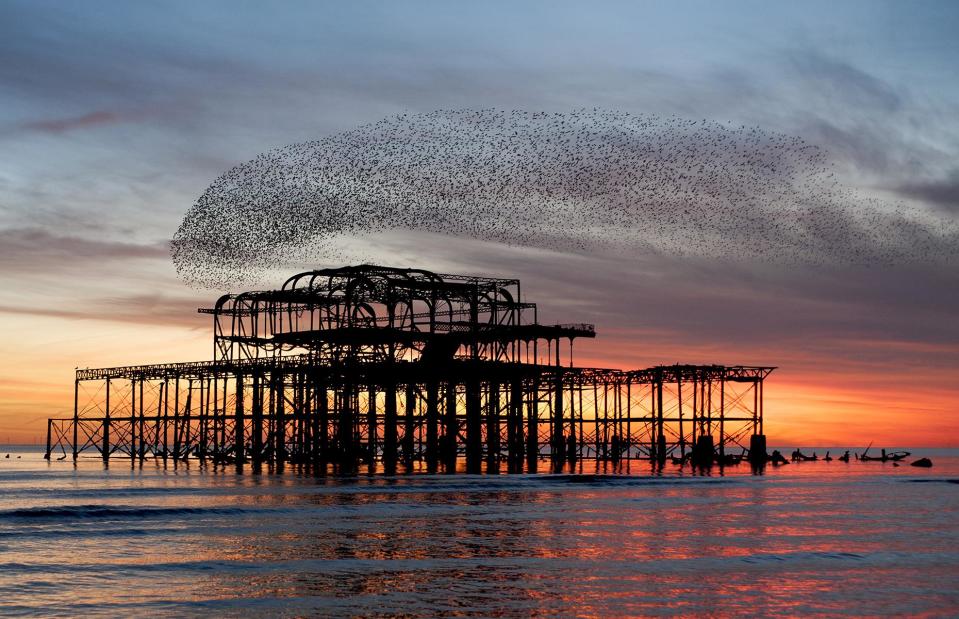
Philip Reeve/Shutterstock
Every autumn the skies all across the UK are suddenly filled with swooping masses of birds whirling in the sky above. Known as starling murmuration, the small songbirds gather in flocks to perform incredible aerial stunts in unison during the hour before sunset.
It's thought that the birds do it to group together for safety against predators, to keep warm at night and to exchange information about good feeding grounds.
The freezing of Niagara Falls, Canada/USA
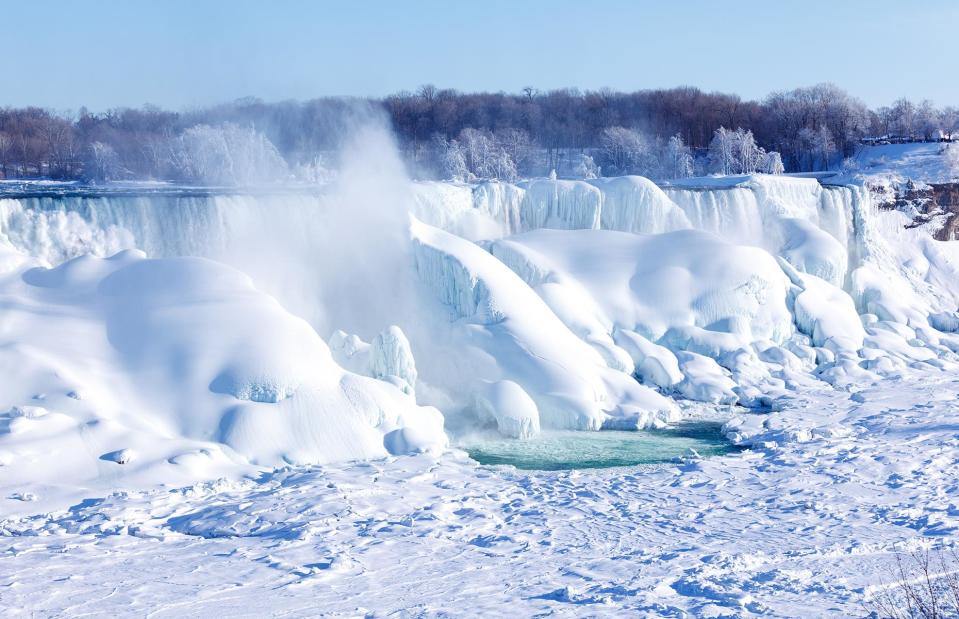
Wally Stemberger/Shutterstock
The breathtaking Niagara Falls are three waterfalls located on the border between the US state of New York and the Canadian Province of Ontario. During winter, temperatures can plummet to as low as -25°C (-13°F), turning the falls' cascading torrents of water into mesmerising ice formations.
The surrounding area is also blanketed in a thick covering of snow, creating a truly magical winter scene.
Red moon
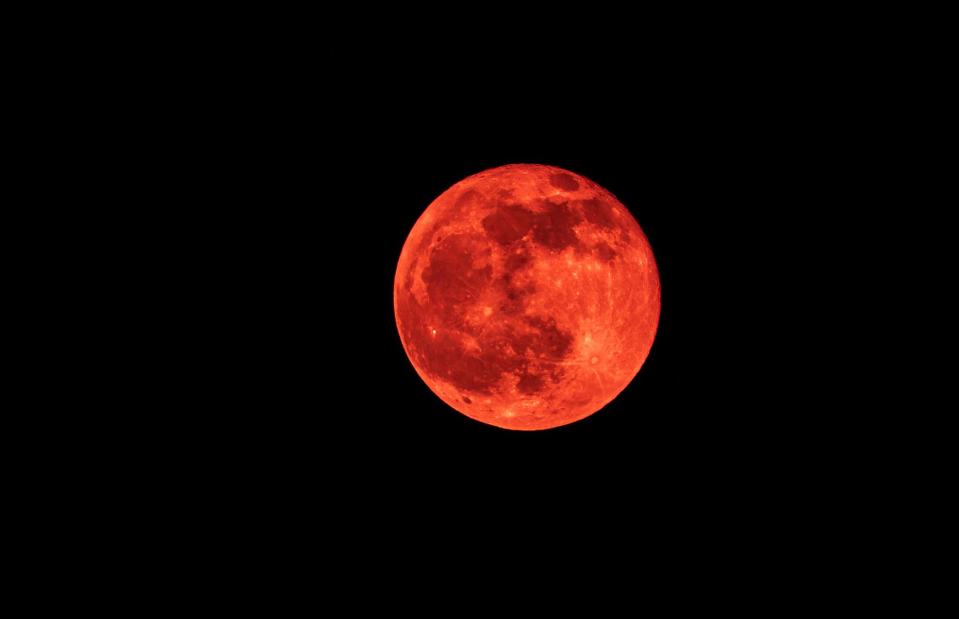
domeniconardozza/Shutterstock
Also known as a blood moon, this blazing display happens during a total lunar eclipse. Although surrounded by many superstitions and prophecies, the red hue is actually due to the red edge of the Earth's shadow, which is reflected on the moon.
It can be seen around the world, although it's at its best in Alaska, the Hawaiian Islands and the west of the USA.
Blooming lavender, Provence, France
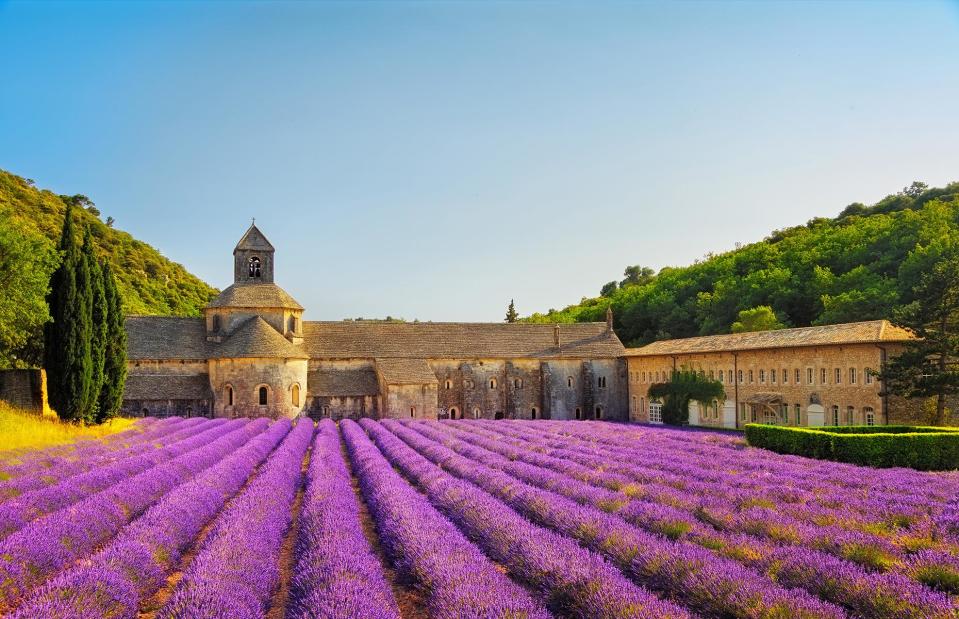
StevanZZ/Shutterstock
The lavender fields of France's Provence region explode in a fragrant haze of purple from around mid-June up until August (though they're at their peak in early July). The most concentration of lavender fields is on the high plateau around Sault, at the foot of the Mont Ventoux and around Apt and Gordes.
Lavender is an important part of life in Provence as it has countless uses, from beauty products and soaps to aromatherapy, as a natural remedy and even in cooking.
Bat exodus from Deer Cave, Malaysia
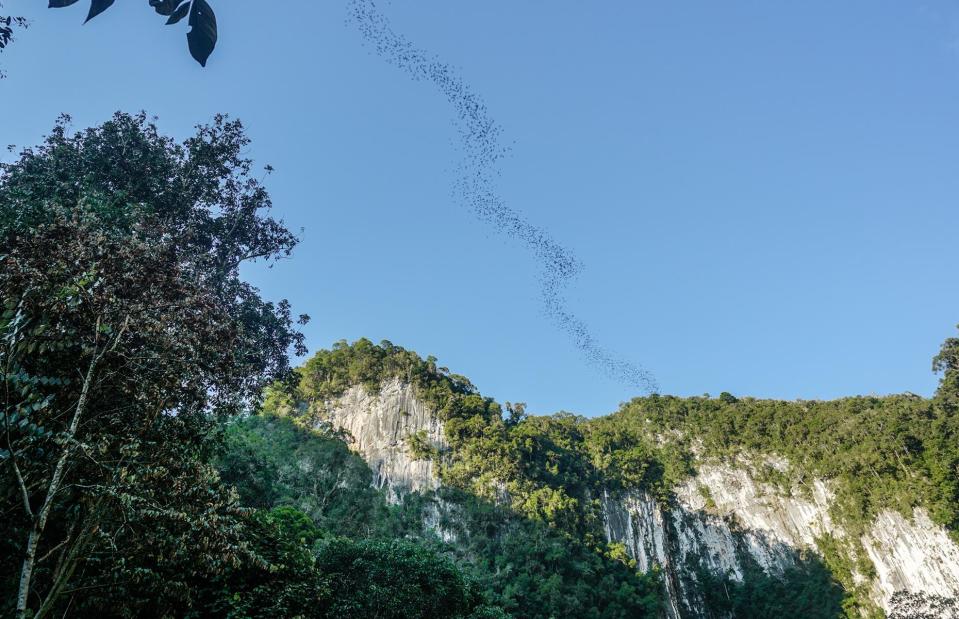
Scott Biales DitchTheMap/Shutterstock
A pretty spectacular show occurs every evening in Borneo's Gunung Mulu National Park. As dusk arrives, three million wrinkle-lipped bats leave the Deer Cave in a snaking stream to hunt for airborne bugs.
It's probably also one of the smelliest sights as the bat poop creates one of the planet's most gag-inducing stenches.
Crab migration, Christmas Island

James D. Morgan/Getty
Between October and November each year, approximately 120 million red crabs make their annual migration from the forests of Australia's Christmas Island to the surrounding tropical waters to breed. Paying no attention to the island's residents, which they outnumber 60,000 to one, they can be seen waltzing along the streets en-mass.
Salmon run, Alaska, USA
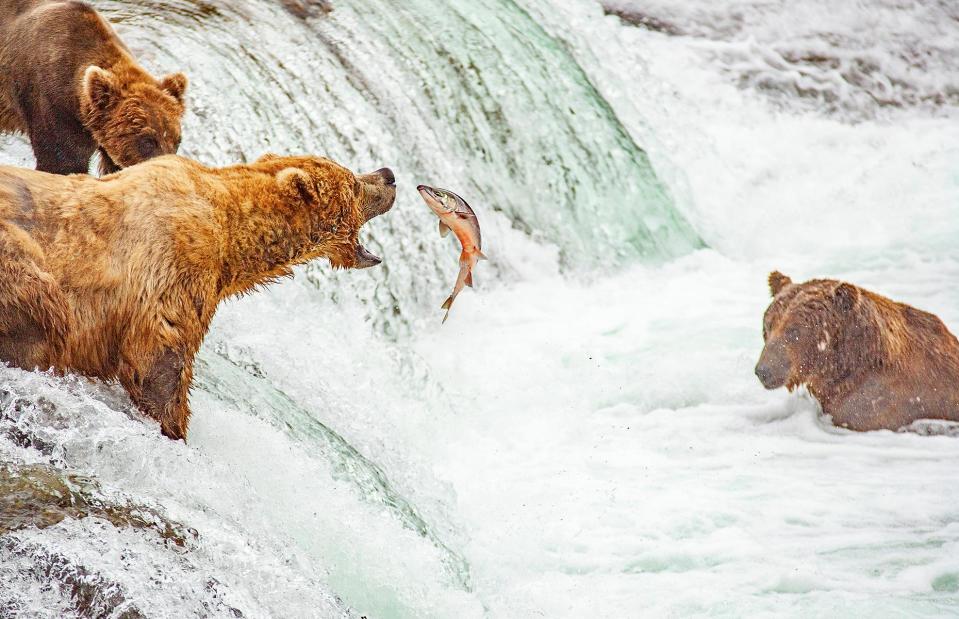
oksana.perkins/Shutterstock
In high summer, between July and September, the salmon run in Alaska lulls brown bears into a feeding frenzy. The salmon travel upstream during this time to reach gravel beds for spawning.
This incredible journey requires the fish to jump up small waterfalls and the leaping and frolicking salmon is what attracts the bears (and eagles), as the fish are plentiful and relatively easy to catch so the bears can fatten up before winter.
Jindo Sea parting, South Korea
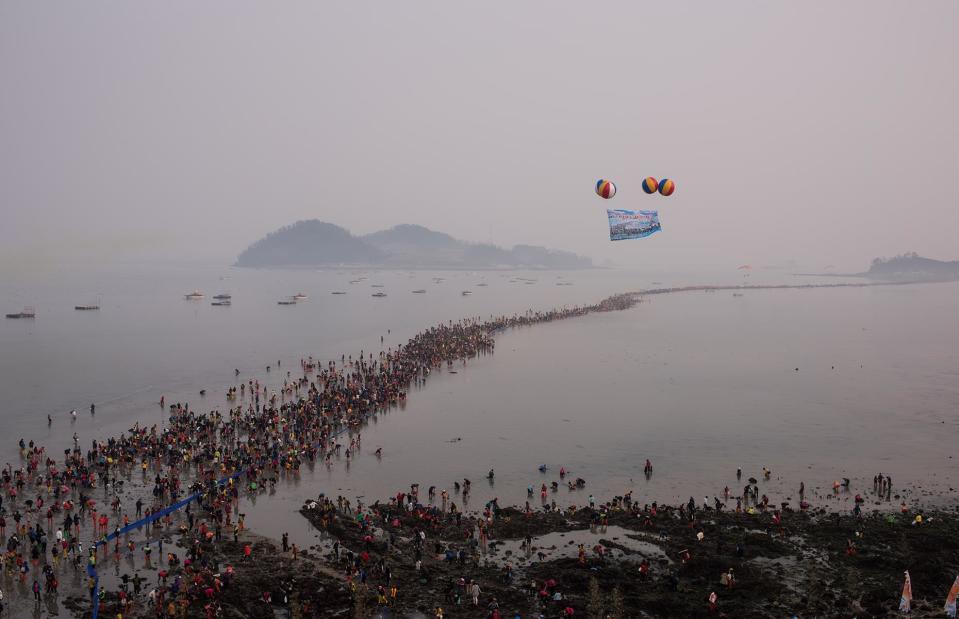
ED JONES/AFP via Getty Images
A Biblical miracle of sorts occurs every year at the southern tip of Korean Peninsula. The Jindo Sea, separating the Jindo and Modo islands, parts just enough to reveal a 1.8-mile (2.9km) pathway.
Although there is only one annual festival, the sea parts two or three times a year between March and June. In reality, this unique event can be explained by extremely low tides. Here, festivalgoers are seen crossing the pathway, digging for clams and gathering seaweed in 2015.
Blooming canola flowers, Luoping, China
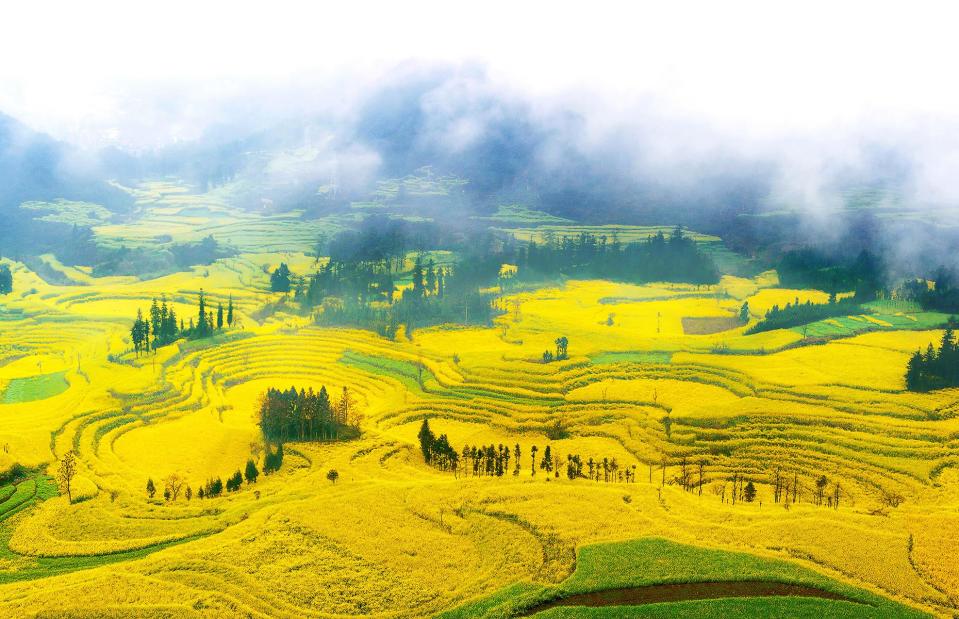
Guitar photographer/Shutterstock
Another incredible event where man and nature come together, every spring 20 contiguous acres in Luoping in China are clad in an ocean of yellow. The county is home to one of the world's largest plantations of rapeseed flowers, also known as canola.
As the golden buds bloom every February and March, the unique beauty is celebrated during Canola Flower Festival.
Iceberg drifting, Newfoundland and Labrador, Canada
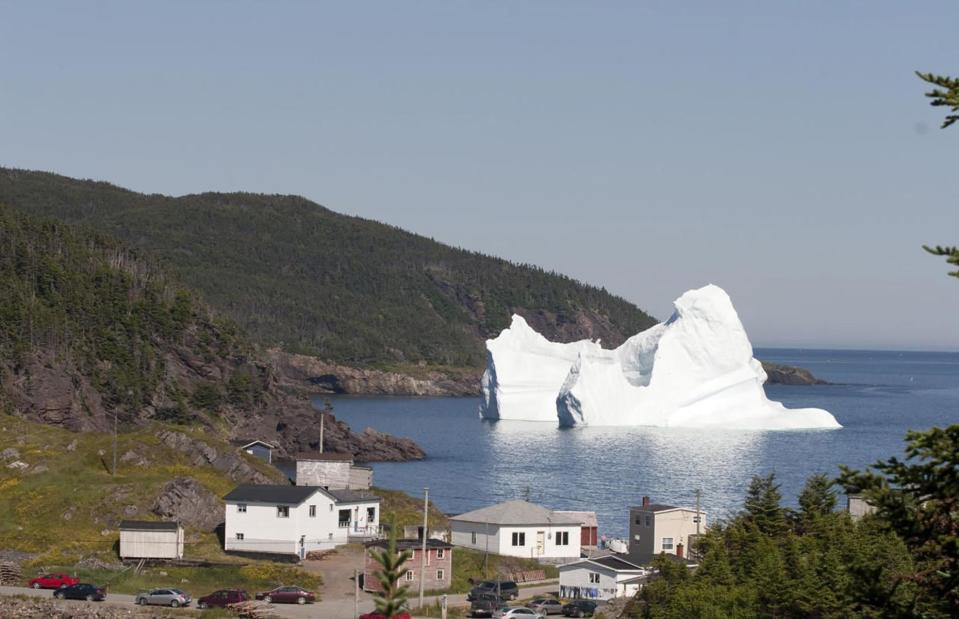
Newfoundland & Labrador Tourism
The so-called Iceberg Alley off the coast of Newfoundland is no stranger to massive icebergs and every year in spring all shapes and sizes of these frozen giants slowly drift past. Funnily enough, this event coincides with the annual whale migration in the opposite direction making for quite the spectacle.
Spring wildflowers in Antelope Valley, California, USA
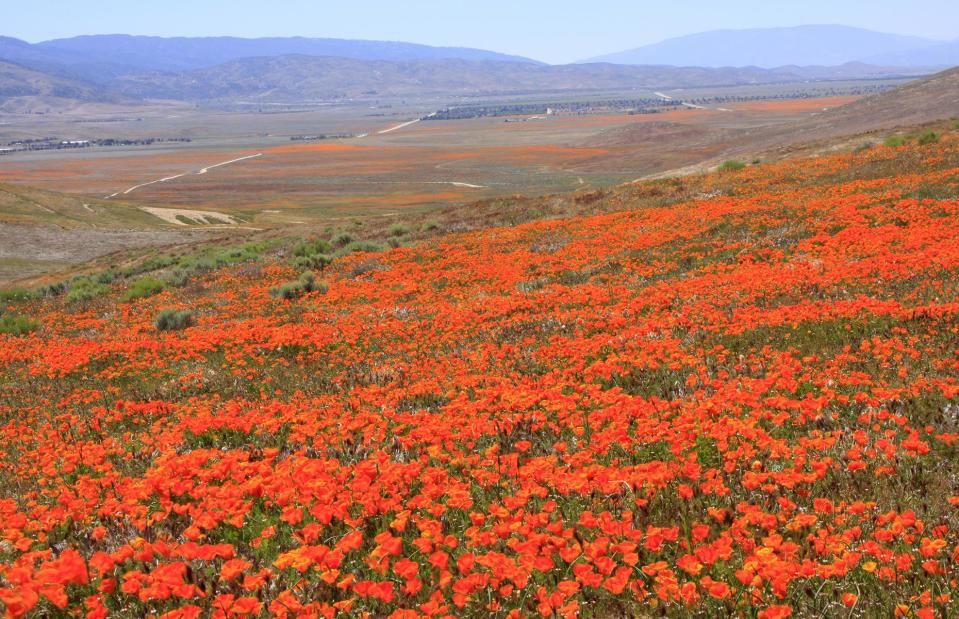
Alessandro Campagnolo/Shutterstock
Each spring, Mother Nature puts on a truly captivating display in the heart of the Antelope Valley, California. Situated on the western tip of the Mojave Desert, these rolling hills come to life for just a few months with colourful flora that turns the fields here purple and gold.
Reminiscent of a Claude Monet painting, the valley becomes awash with native California poppies, lacy phacelias and delicate fiddlenecks.
Lenticular clouds
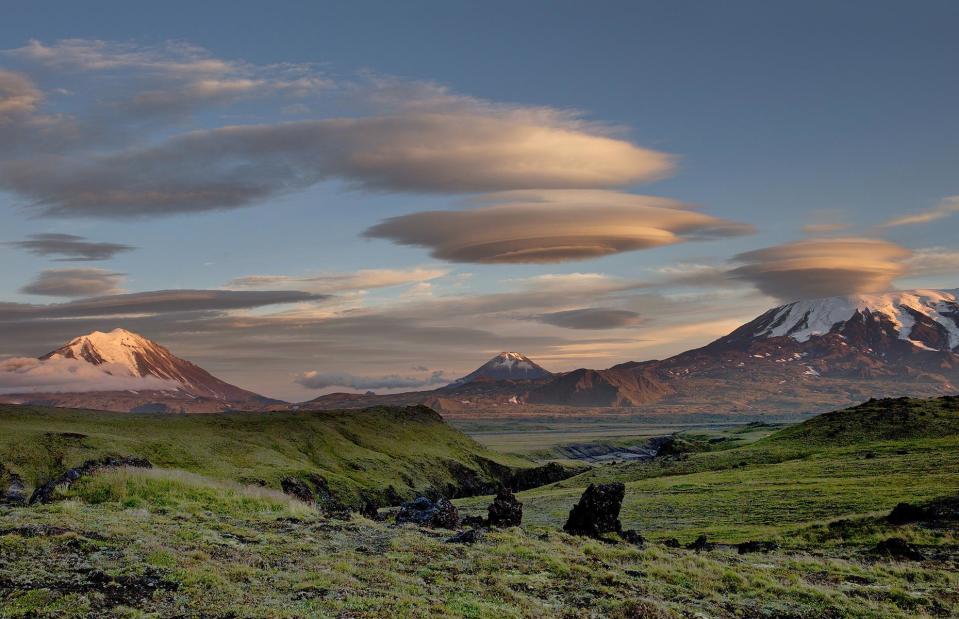
Michael Dorogovich/Shutterstock
Regularly mistaken for flying saucers, these lens-shaped clouds – which appear singular or stacked like pancakes – are very different from any other type of cloud because they don’t move. They can appear anywhere but are most commonly found in mountainous regions and are avoided by pilots due to the heavy turbulence they can cause.
Five Flower Lake, Sichuan, China
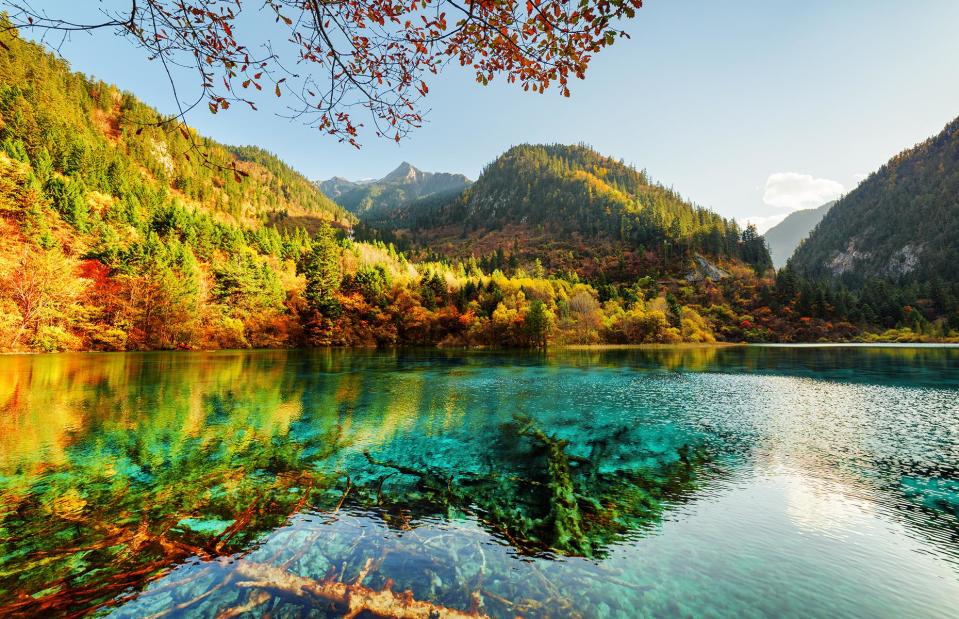
Efired/Shutterstock
China's Jiuzhaigou Valley is on the UNESCO World Heritage list for very good reason and Five Flower Lake is perhaps its most dazzling feature. This serene lake is considered holy by many locals, thanks to its interchanging colours and the fact it doesn't freeze, even in winter.
Yet the mystery behind this unique wonder can be easily explained – home to hot springs, the pool also has aquatic plants which change colour when exposed to sunlight.
Bioluminescent plankton, Thailand
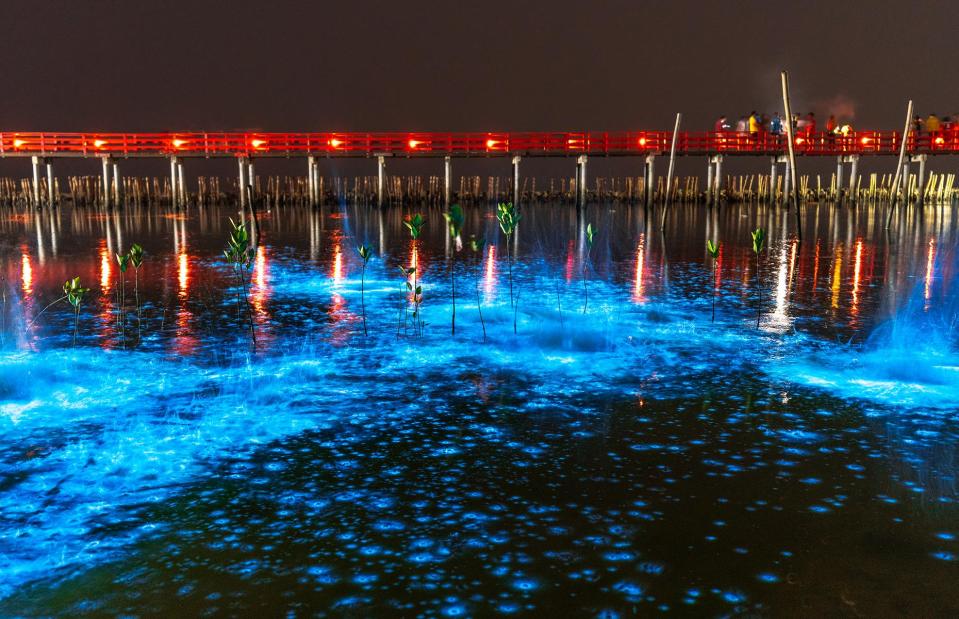
Sugrit Jiranarak/Shutterstock
Dinoflagellates are tiny, bioluminescent marine plankton found in waters around the world, but one of the best places to see this spectacular show is Thailand. Especially vivid during the full moon, this glowing phenomenon can also be observed in Sri Lanka, Vietnam, Jamaica and even San Diego in California.
The explanation behind this magical glow is pretty simple – the plankton use it as a defence mechanism to draw predators to the creatures trying to eat them.
Blooming lupins, Lake Tekapo, New Zealand
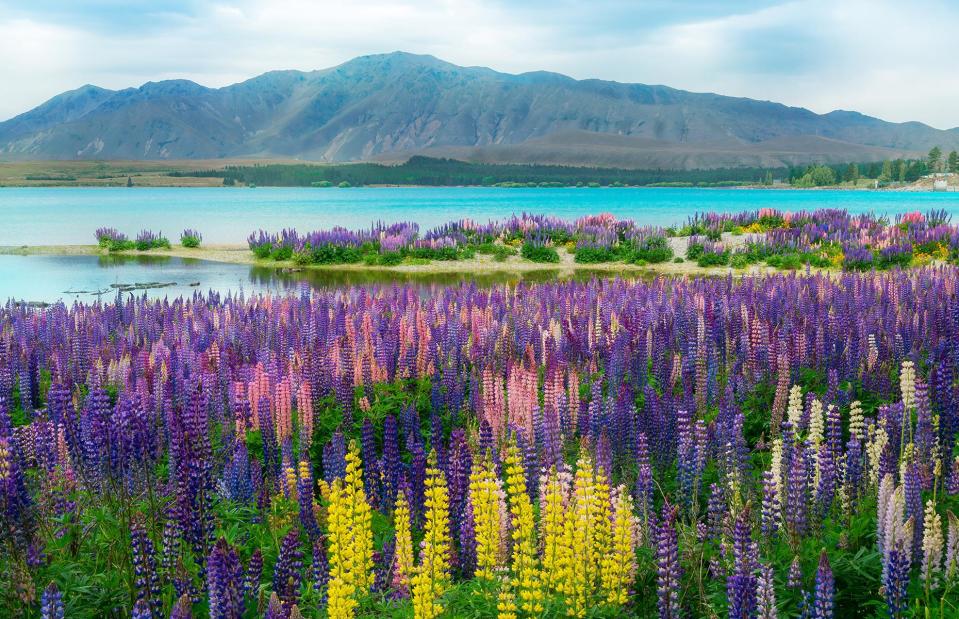
Blue Planet Studio/Shutterstock
Although lupins are found pretty much all across New Zealand's South Island, these gorgeous flowers are at their most beautiful in Lake Tekapo. Putting on a spectacular show between September and February (during spring in the Southern Hemisphere), the flowers really come into their own around November, when the blooms are at their most colourful, cladding the shores of lakes and rivers in a sea of pink and violet.
Racetrack Playa, California, USA
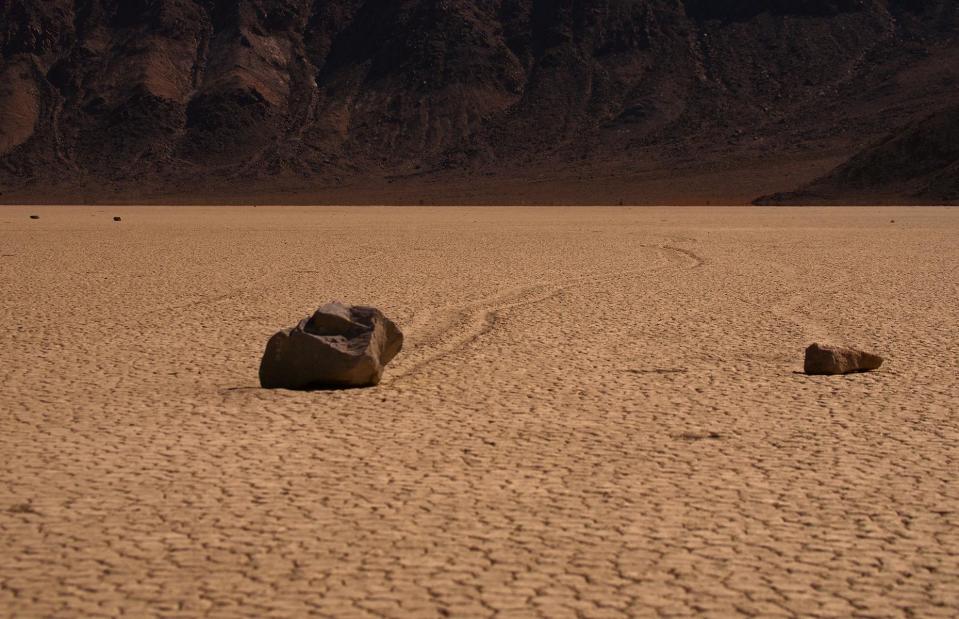
Peterson-Media/Shutterstock
Is it some unexplained magnetic force that causes rocks to glide across this cracked, dry lakebed in California’s Death Valley? Or the unseen hands of some higher power?
Neither, it seems, as scientists debunked the mysteries in 2013, discovering the boulders are moved by wind when the ground is icy. It’s still a hauntingly beautiful – and delightfully odd – place.
Blooming jacaranda trees, Pretoria, South Africa
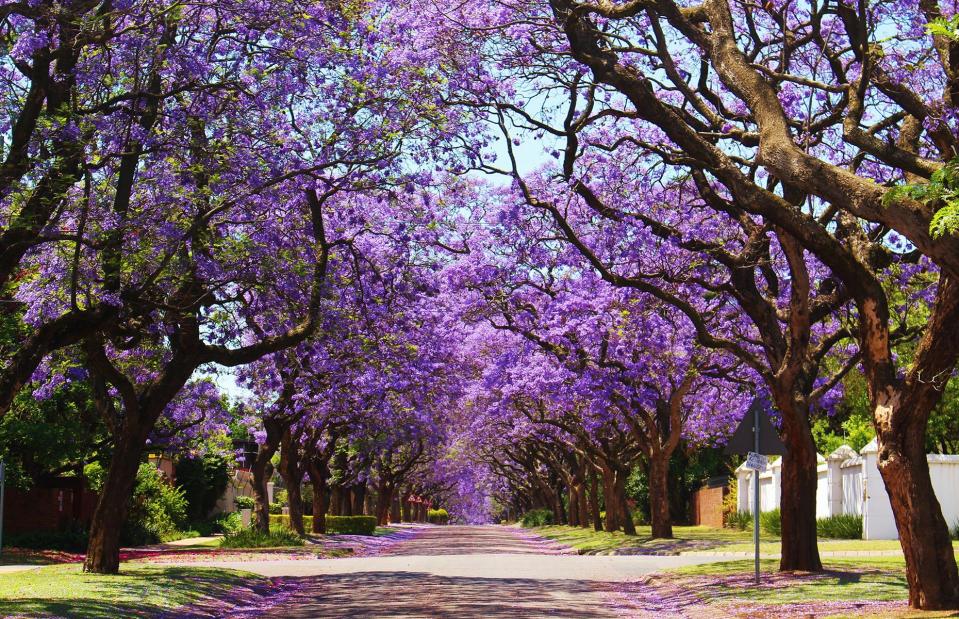
Heidre Heyns/Shutterstock
Late-September to late-November is the time to visit South Africa if you want to catch a glimpse of the jacaranda trees’ annual floral display. Boasting mostly purple, fragrant blooms (although you may spot some trees with white flowers), jacarandas can mostly be found in Pretoria and Johannesburg. In fact, it’s thought that there are more than 70,000 jacarandas in Pretoria alone.
March of the emperor penguins, Antarctica
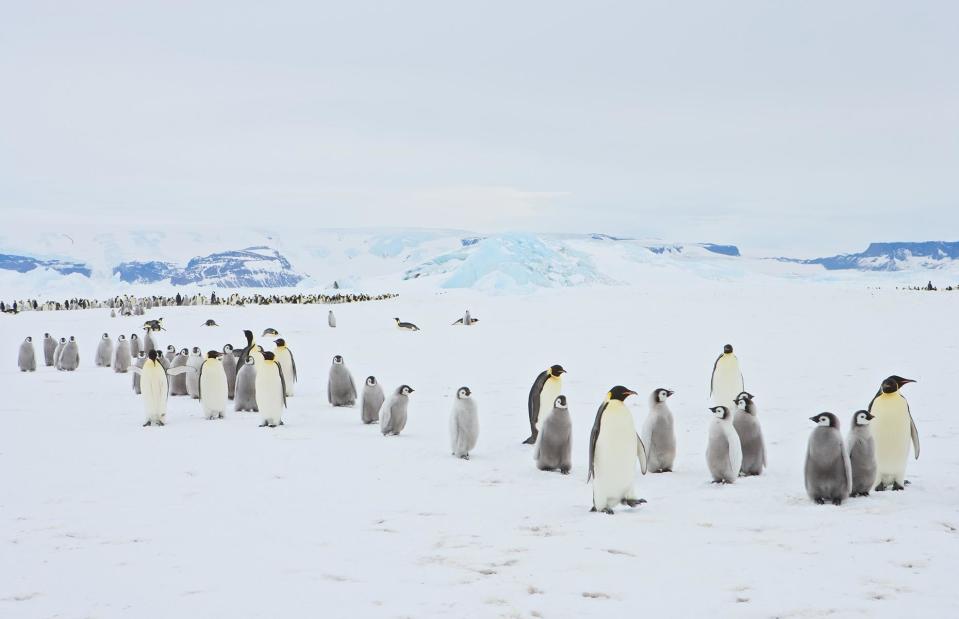
Enrique Aguirre/Shutterstock
Every year at the end of Antarctic summer, the emperor penguins make a short journey from open water to their breeding ground. After the eggs are laid, the males huddle together through the freezing Antarctic winter to incubate the eggs while females return to sea to bring back food for the young and the males in spring.
As spring and penguin chicks arrive, open water for feeding can be as far as 62 miles away (100km) after the storms of Arctic winter, so every March penguins of all ages embark on this epic journey.
Okavango Delta flooding, Botswana

Grodza/Shutterstock
The Okavango Delta in Botswana is described as Africa's last Eden – not too bold a claim given the unspoiled nature and diverse wildlife of this sprawling lush green wetland area. The fluctuating delta is created as the Okavango River floods the Kalahari Desert, and is at its largest from March through to June.
Some 160 species of mammal can be found within the delta area from the African bush elephant to big cats like lions and cheetah.
Frozen bubbles, Lake Baikal, Russia
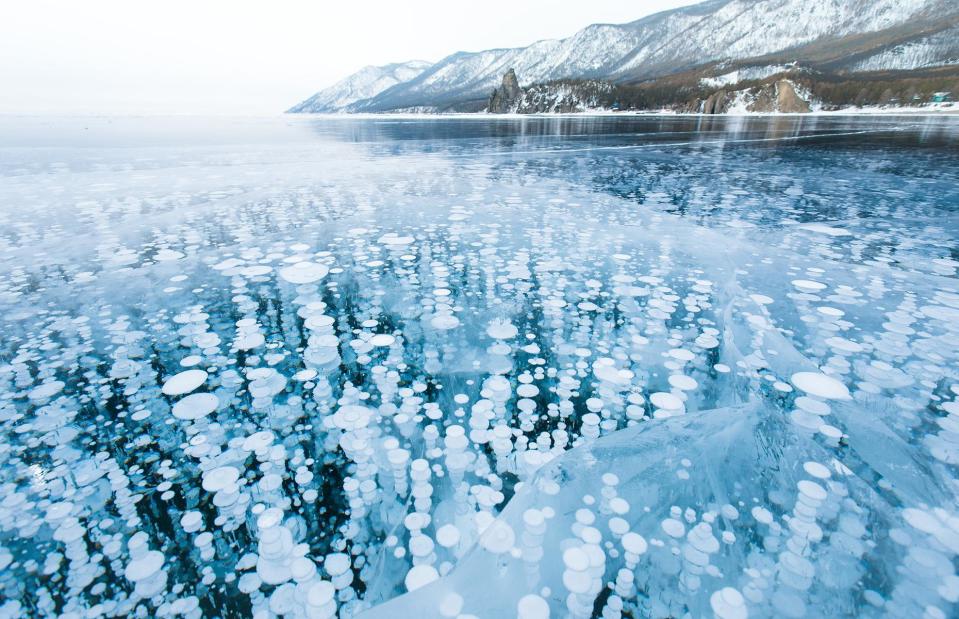
Strelyuk/Shutterstock
Although this natural wonder looks mysterious and totally inexplicable, there's actually a very simple explanation behind these beautiful bubbles trapped underneath the ice. As organic matter at the bottom of the lake releases methane gas, it rises in bubbles which then freeze as soon as they come in contact with the frozen water. This phenomenon can be observed in Russia's Lake Baikal every year, however, it's been spotted in Alberta's Abraham Lake in Canada too.
Caribou migration, North America
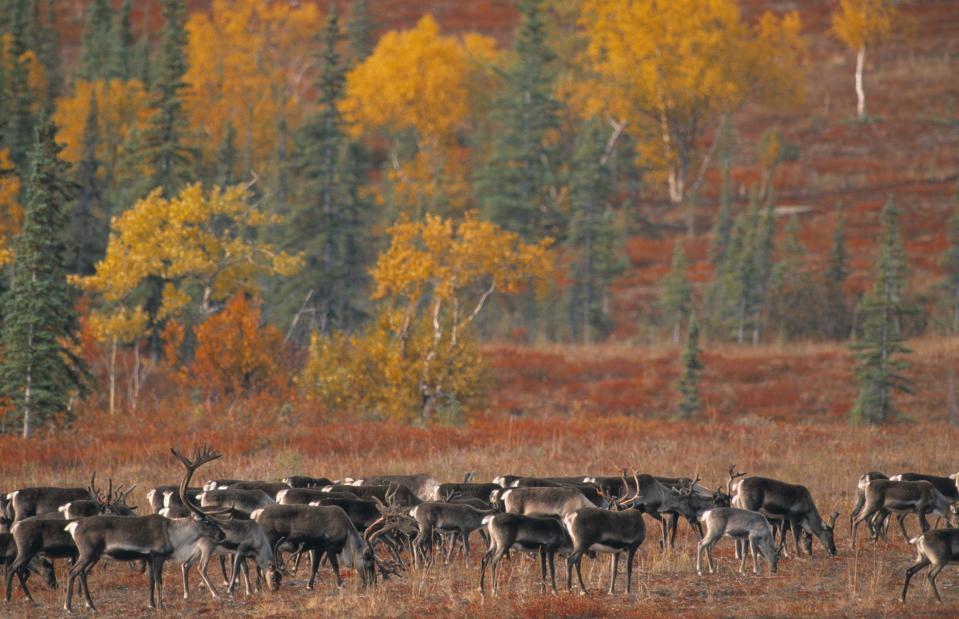
BMJ/Shutterstock
As summer approaches, caribou (North American reindeer) embark on an epic 600-mile (966km) journey north. Known as one of the world's great large-animal migrations, the caribou head to feed on the abundance of grass and plants of Arctic Canada's tundra.
Adults can consume as much as 12lbs (5.4kg) of food a day. Once the first snow comes, the animals turn back south to spend the winter in milder climes with their young.
Catatumbo lightning, Catatumbo River, Venezuela
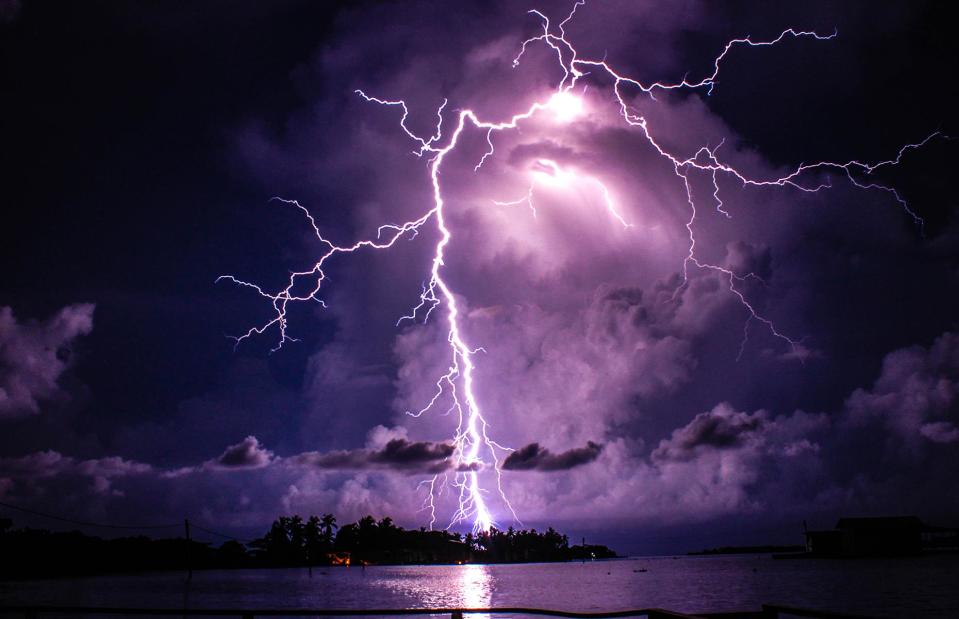
christianpinillo/Shutterstock
Unique to Venezuela, this type of lightning can only be observed over the mouth of the Catatumbo River where it empties into Lake Maracaibo. The lightning show occurs approximately 260 nights a year, 10 hours per day and up to 280 times per hour, however in 2010 it ceased from January to March due to a drought, leaving many in fear that the famous lightning might be extinguished permanently.
Batad and Banaue rice terraces, the Philippines
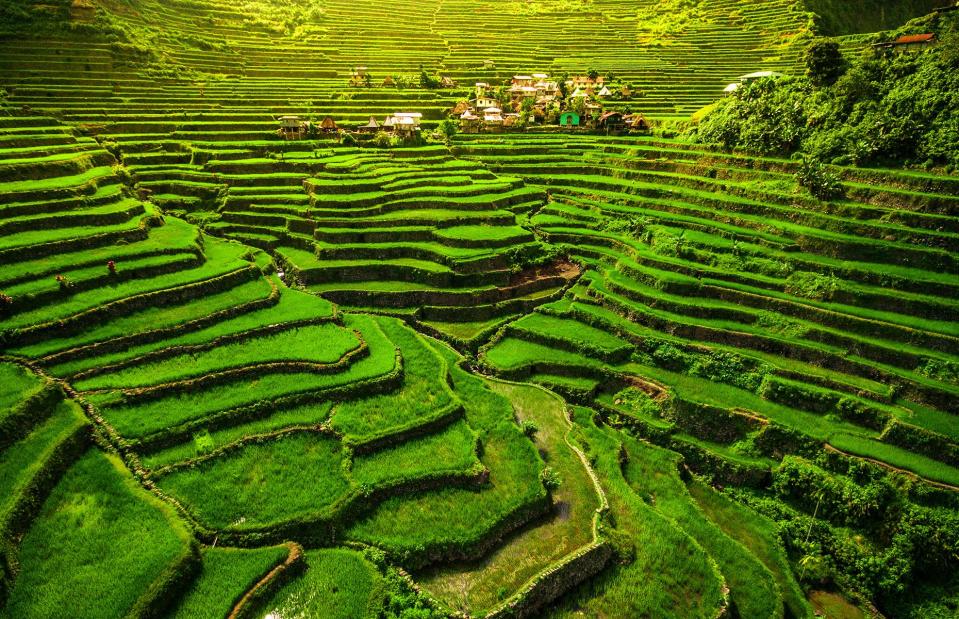
R.M. Nunes/Shutterstock
Hand-carved into the mountains some 2,000 years ago, the rice terraces in the Philippines’ Ifugao province are a staggeringly spectacular combination of natural and man-made beauty. There are five vast, UNESCO-listed terraces stretching hundreds of feet into the air.
Legend has it that if you joined all the paddies end to end, they’d reach halfway around the Earth. The terraces are at their most beautiful in late spring when the young rice give the terraces a lush green colour.
Flamingo migration, Kenya and Tanzania
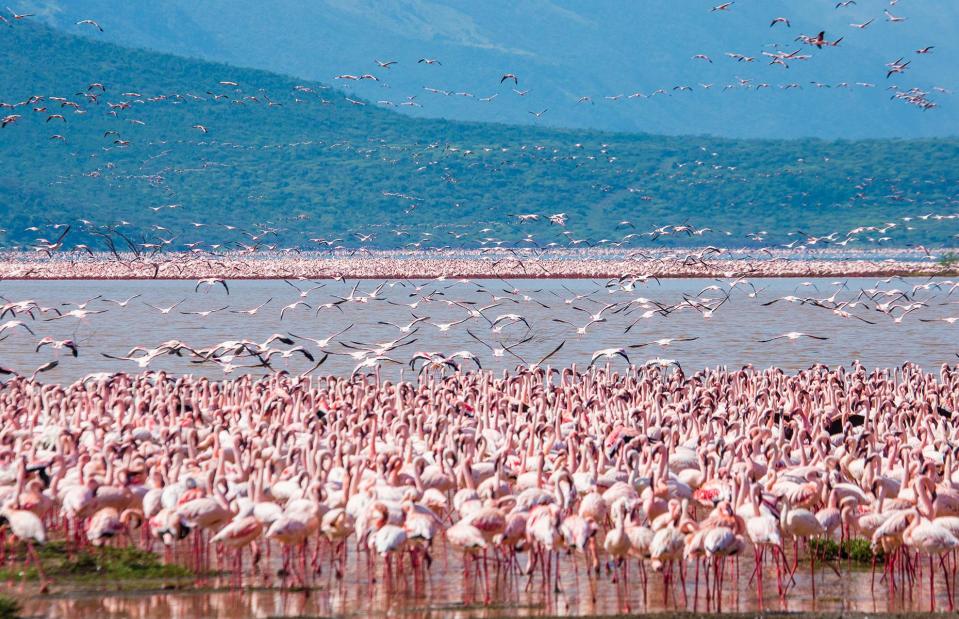
GUDKOV ANDREY/Shutterstock
Each year during the peak of dry season in July and August hundreds of lesser flamingos, a species found in sub-Saharan Africa, flock to the algae-rich waters along eastern Africa's Rift Valley to feed. Preferred locations for this hardy bird, which have tough skin and scales to adapt to a wide range of environments, are the normally inhospitable, hypersaline waters of Lake Bogoria in Kenya and Lake Natron in Tanzania.
Horsetail Fall firefall, California, USA
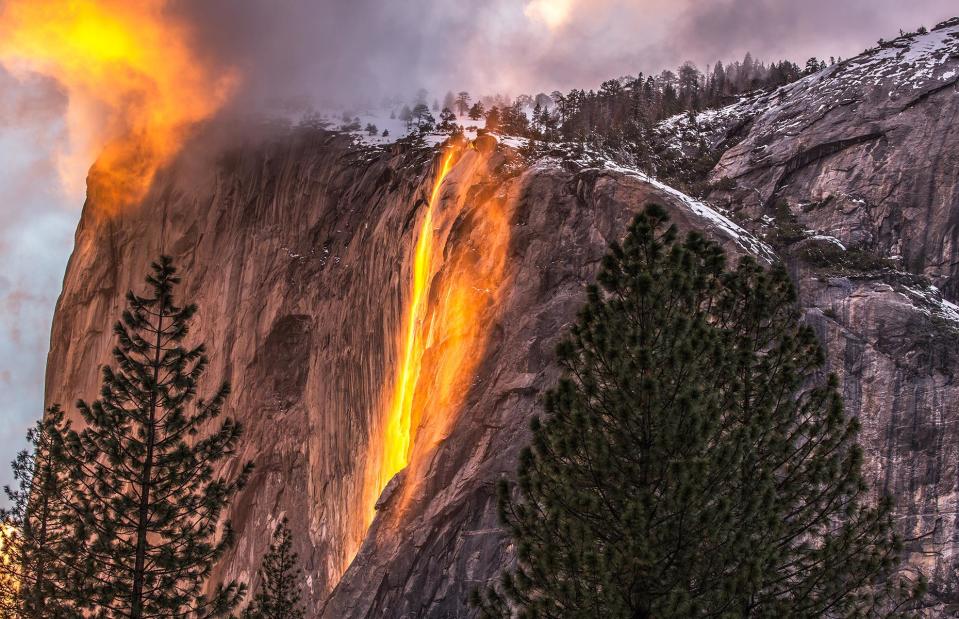
Gregory B Cuvelier/Shutterstock
Horsetail Fall is a seasonal waterfall that flows down the east face of El Capitan (a vast rock formation in California’s Yosemite National Park) in winter and early spring. It's a sight to behold in itself, but during a 10-minute window over a few days in mid-to-late February it becomes even more special.
The setting sun tilts at just the right angle and casts a glowing light that transforms the spectacle into a 'firefall', so named for its likeness to free-flowing lava.
Now check out these jaw-dropping places you can only see in photos

